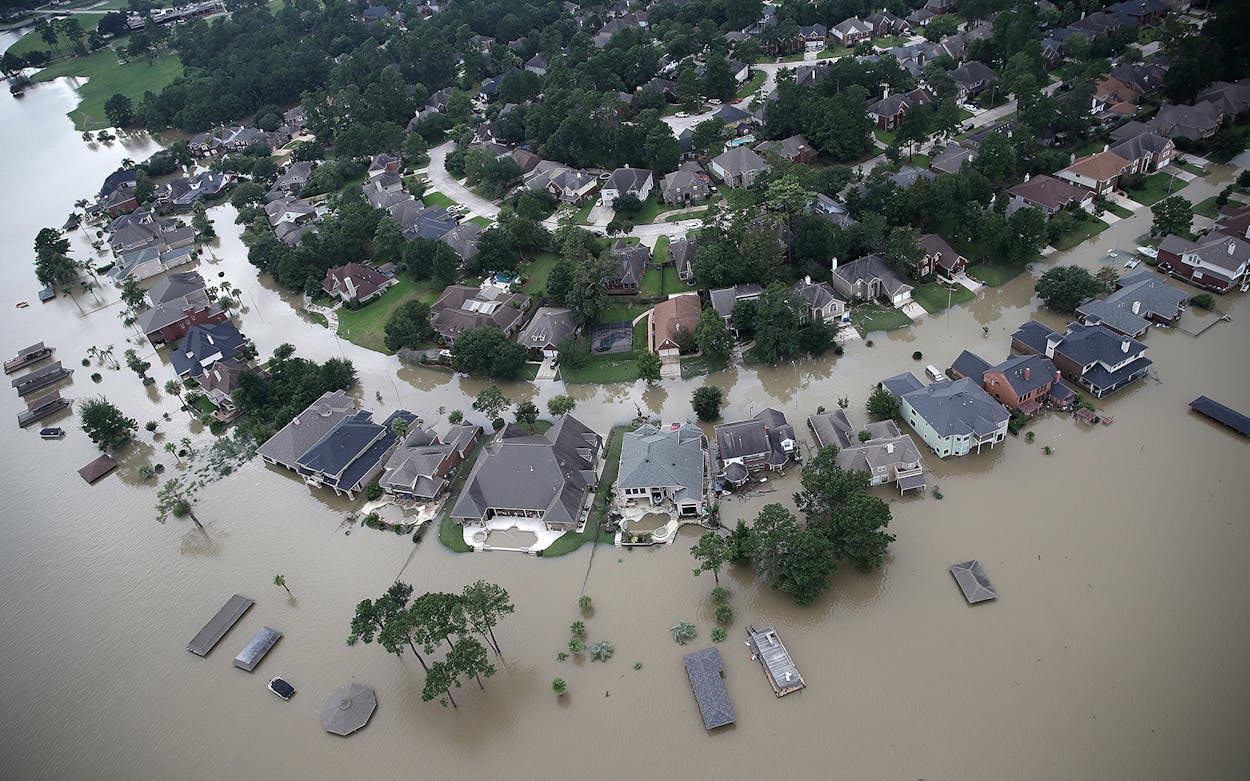The language we use to talk about major weather events minimizes the risks. That may be by design: “100-year-flood” sounds almost biblical, like something that’s so deeply unlikely to happen that most people will likely live their entire lives without ever encountering one. “A 1% chance each year that a storm might drop 20 inches of rain on your house,” on the other hand, puts it in more mathematically present terms.
The “X-year-storm” language gets the point across, though, when we talk about the new study from Kerry Emanuel, professor of atmospheric science at the Massachusetts Institute of Technology. According to the study, entitled “Assessing the present and future probability of Hurricane Harvey’s rainfall,” a storm that produces more than twenty inches of rain occurring anywhere in Texas has, using the data from between 1981 and 2000, been a 100-year storm. Using the National Hurricane Center’s models and six different climate models, the study finds that by the end of the 21st century, such storms will be more like a 5 1/2 year event.
“It’s very, very easy for people—even scientists—to get confused by this. You have to be very careful with what you mean by the event,” Emanuel says. The study looks at both Harvey-like storms hitting the greater Houston metro area (which he forecasts will go from a 2,000-year-storm to a 100-year-storm), as well as storms of that size making landfall anywhere in Texas, which is how we get to the 5 1/2 year number. “If I were to say that the chances of your house there in Texas being hit by a tornado was one a million, and someone responded, ‘But there were ten houses destroyed in Texas by tornados last year,’ they’re both correct statements,” he says. “The definition is your house being hit by a tornado, as opposed to somebody‘s house.”
Emanuel and his team developed the methodology they used for the Harvey study over the past twelve years, and they’ve done hurricane analyses with these methods all over the world. For this one, though, they moved “unusually fast” in publishing it, in order to make sure that people in Houston and other parts of Texas are armed with updated forecasting as they begin to make decisions about rebuilding infrastructure, and what kind of floods to plan for.
Mostly, to Emanuel’s mind, that involves more intelligent building codes and plans for dealing with flood waters, but he’s willing to indulge some big ideas for hurricane mitigation, including one invented by former Microsoft Chief Technology Officer Nathan Myhrvold that would use wave-driven pumps attached to floating buoys, with long stems that go deep into the ocean and pump cold water up to the surface. “The idea is that you deploy these with an aircraft ahead of an approaching hurricane, and that would enhance the hurricane’s own ability to pump cold water up, and that would decrease its intensity,” says Emanuel. “We actually could do that. It’s not magical. The technology is very off-the-shelf stuff, it’s very boring to an engineer.” The problem, he says, is an economic one. When his team analyzed the idea for a wind storm in Florida—a situation where flooding wasn’t considered an issue—they concluded that given the cost of deploying Myhrvold’s devices, they’d be better off just handing out plywood to people so they could board up their houses. “But,” he adds, “that doesn’t mean that would be true for Houston for a flood. We do consider radical measures.”
There’s no study evaluating the cost-effectiveness of a system like Myhrvold’s in the face of a Harvey-like storm, but ideas that seem like science fiction do excite experts like Emanuel. The professor sees promise in projects like the massive underground flood tunnels in Tokyo, which were completed in 2009. Those tunnels—more than 580 feet long, 255 feet wide, 82 feet tall, with fifty-nine 500-ton concrete pillars holding them up, capable of pumping 200 tons of water per second—were a massive infrastructure decision designed to change the city’s relationship to flooding.
“This is the kind of thing that Houston might contemplate,” Emanuel says. “Are there ways to engineer your way around these problems in the future?”
The study also finds that, while models show that the number of hurricanes that occur anywhere on the earth each year may actually decrease over the next hundred years, their severity and their chances of making landfall—especially in Texas—are likely to go up.
“When you look at a particular place like Texas, you have to look at what goes on there, specifically,” Emanuel says. In Texas, there are two big contributors to the increase in expected rainfall. Warmer air holds more water vapor, so it ends up producing more rain. And the reduction of the temperature difference between high and low latitudes, which is what drives large-scale atmospheric circulation, means that the circulation becomes weaker, leading to storms like Harvey, which are more likely to stall over land. “In our method, it’s roughly equal contributions of more water and longer duration of events,” says Emanuel.
Emanuel notes that the stalled-out storms are bad news for coastal areas, but it’s actually more of a mixed bag for areas further inland. “For cities that are near the water like Houston is, it’s a bad deal,” he says. “The storm comes over you and stops, and you get hammered. If you’re inland—San Antonio, or Dallas—the slowing down of storms is actually a good thing, because it means that the storms will have petered out by the time they get to you.” Emanuel’s team doesn’t have a clear prediction on what inland cities in Texas can expect over the next eighty years—but for those on the coast, those hundred-year-storms threaten to get a lot more frequent.








